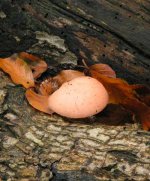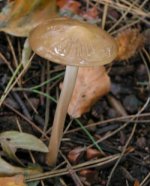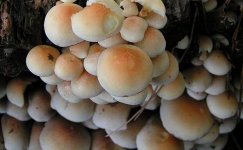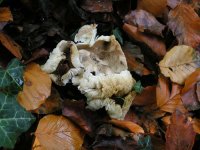Leif said:
Actually for 4 my preferred choice was T. argyraceum based on the cap colour and texture. However I believe that many/most authors consider it to be the same species as T. scapturum. I get rather confused as some books recognise several distinct species that others consider merely as variants of one species and I do not know who to believe.
Yes, the pale ground colour does suggest the true
T. argyraceum, though I don't feel it matches that species in other respects. I still think it is
T. scalpturatum that has lost colour with age, and the beech habitat makes
T. scalpturatum much the more likely of the two.
The 1960 checklist of British agarics regarded
T. scalpturatum as a synonym of
T. argyraceum and this tradition continued in popular guides. Roger Phillip's book, for example, didn't separate them, and consequently his photograph under the name of "
argyraceum" is actually
scalpturatum.
The BMS database has them separate now, but it seems from the records that
T. scalpturatum is still being recorded as the much rarer
T. argyraceum. British records are hopelessly confused.
European authors have recognised the distinction much more clearly. Moser's keys separated the two on modern lines (albeit with unreliable habitat distinction) and Bon's
Tricholoma monographs (especially his 1995 revision of
Tricholoma in Europe:
Die Grosspilzflora von Europa, vol. 2) gave further clarification. Volume 9 of Marchand's
Champignons du Nord et du Midi, very valuable for identification of critical
Tricholoma species, gives excellent photographs of both.
Two of the best recent field guides,
The Mushrooms and Toadstools of Britain and North-Western Europe, by Bon, and
Mushrooms and Toadstools of Britain and Europe by Courtecuisse and Duhem, separate the two and give useful illustrations.
Basically,
T. scalpturatum is the common species, chunky habit, conspicuous dark scales on the cap surface, gills and flesh strongly yellowing with age, under a variety of trees, often with beech.
T. argyraceum is much more slender, often with a relatively longer stipe, very pale silvery grey cap with small, usually inconspicuous scales much the same colour as the cap surface, flesh and gills not or only weakly yellowing with age, again with a variety of trees but apparently most often with birch or oak.
Additional microscopic characters are given by Noordeloos & Christensen in
Flora Agaricina Neerlandica vol 4.
In my own experience these distinctions work, but I have to admit that the other recent European
Tricholoma monograph, Riva's
Fungi Europaei vol 3, with beautiful colour plates, allows
T. argyraceum to be darker, though still with a pronounced silvery texture, and sometimes with conspicuous scales.
So yes, they were grouped together in the past, but I'd say that there is pretty much a consensus amongst authors now that there are two species, albeit not always easily told apart. (Plus a couple of others in the same aggregate.)
Leif said:
Hygrocybe conica is another confusing species that some authors split.
Yes, most of the recent monographs keep
H. conica as one species. However, having been running a student exercise for several years in a rich waxcap area, I am coming to the conclusion that
H. pseudoconica, at least, is ecologically very distinct. Still, that is a whole new topic!







